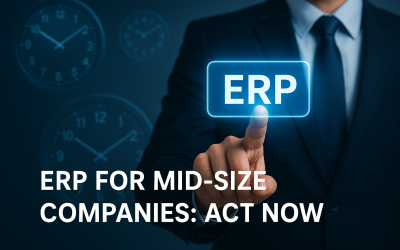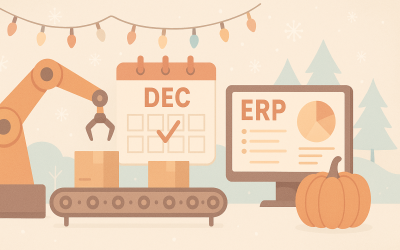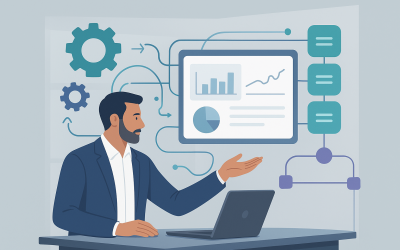With the global ERP software market expected to be worth $41.69 billion by the beginning of 2021, the impact of these systems is evident. While that number is impressive, those who’ve never used the software may find it difficult to understand why ERP is important to their business. But as globalization squeezes the market for many industries, it’s essential to seek out any and all tools to give your business a competitive edge. For many companies, this is achieved through the use of ERP.
Benefits
Enterprise resource planning (ERP) is used by organizations looking to manage their business functions within a centralized and integrated system. ERP is commonly used by companies working within the supply chain to help keep track of all the moving parts of manufacturing and distribution. However, ERP can be utilized by a number of different industries including those in healthcare, nonprofit groups, construction, and hospitality. Organizations needing to manage their staff, customers, and inventory can all rely on ERP benefits.
ERP stores all entered data into a single database, allowing all departments to work with the same information. Additionally, all this data can be organized, analyzed, and made into reports. ERP brings together customer management, human resources, business intelligence, financial management, inventory, and supply chain capabilities into one system.
Why ERP is Important
Enterprise resource planning software is used to manage a number of business functions, but how is it any better than other solutions? Even though ERP may have similar goals to other solutions, its unique features make it a distinctive competitor in the software market. Here are the eight reasons why the importance of enterprise resource planning (ERP) systems should be considered by any organization:
1. More Money Saved
Although many vendors have introduced flexible pricing in recent years, ERP packages are still a big investment. For many, the large costs alone can make it seem unlikely that the program would end up saving your organization any money at all. But once you get past the sticker shock, it’s easier to see how ERP can provide an excellent ROI.
First, ERP unifies many of the systems that may currently be fragmented in your organization. From product development to accounts payable, your staff will be able to access all the necessary tools for their job from one centralized system.
By unifying systems, you help your staff utilize their time more efficiently. With ERP, users don’t have to hunt down a piece of information across multiple systems. With the central database, information is much easier to retrieve. Moreover, your organization saves money with ERP by eliminating the need for users to be trained on several systems. This not only reduces the amount of money spent on training but also reduces the logistical effort involved. Instead of scheduling several training sessions with several different vendors, you only need to communicate with one.
2. Improved Collaboration
The features of ERP applications can vary slightly depending on the program you are using, but generally, all systems improve collaboration in some way. As mentioned before, the centralized database is an integral part of what makes an ERP unique. With this database, you provide your company with a single source of truth to work from. This reduces any errors brought on by working with the incorrect data, further reducing costs.
Moreover, a central database reduces any hesitation or stalling during projects, since all team members have access to the company-wide data they need. Additionally, there’s no need to merge information across various systems or sources. Because all of the data is compiled, stored, shared and accessed through a single system, there is no concern about how accurate, complete or secure the data files are.
This isn’t as easy to say if perhaps your team is entering the same client information over and over again into several different systems. Without an ERP, you invite human error into your processes when it could easily be avoided.
3. Better Analytics
A central database of information also aids in improving your analytics and reporting. Since an ERP records and stores all the data users input, it makes for an excellent business intelligence tool. As long as your vendor provides strong functionality, ERP software makes it easier and faster for your team to generate various reports. Reports that could take days of research and compilation without an ERP takes just minutes.
Most ERP solutions provide a customizable dashboard so executives can see reports when they first log into the system. These reports may include everything from income and expense statements to custom KPIs that offer insight into certain functions. The ability to have access to these reports quickly enables you and your team to make better decisions more quickly. You no longer need to rely on your IT staff to generate the reports that you need. Lastly, reports typically come with access levels, ensuring only relevant staff see valuable company data.
4. Improved Productivity
With traditional methods, tedious tasks are completely unavoidable. Tasks like generating reports, monitoring inventory levels, timesheet tracking and processing orders have historically taken employees hours to accomplish. In addition to taking up time, these processes lower employee morale and open yourself up to human error. After the umpteenth hour of entering the same line of data into different forms, even the best staff members are bound to make a mistake.
If you choose the right solution, an ERP can automate your most tedious tasks. The database within ERP software eliminates redundant tasks such as data entry and allows the system to perform advanced calculations within minutes. This frees up your team members’ time to do more thoughtful work, increasing your ROI when it comes to labor. From this, ERP increases your organization’s productivity, efficiency and profitability.
5. Happier Customers
Managing your customers has never been so important. In our digital age, more and more people are turning to the internet to receive advice on what clothes to wear, what food to eat and how to live their lives. And with 84 percent of consumers trusting online reviews as much as they would a friend, previous customer opinions are more impactful than ever.
The best way to improve customer satisfaction is to provide client-centered goods and services. ERP provides this in a few different ways. First, most ERP are equipped with a customer relationship management (CRM) tool or can be easily integrated with one. With an ERP, your CRM has access to data across business functions.
Along with contact information, an integrated CRM can show you details such as order history and billing information. This enables your team to see your clients more holistically to gain a better understanding of their wants and needs. The increased customer visibility helps you formulate your sales strategy for improved lead generation.
6. Simplified Compliance and Risk Management
As companies grow and do business in different countries, it can be difficult to keep track of all the different regulations imposed on your business. Even local companies need to worry about various environmental, information security and human resources regulations.
Luckily, many ERP offerings are built with these regulations in mind to help you maintain compliance at every stage. Moreover, ERP software provides built-in auditing tools to assist with documenting things like chemical use and tax provisions. This makes it incredibly easy to formulate reports and send them over to the relevant governing body.
Additionally, ERP often provides tools to manage risk. This solution’s enhanced reliability and accuracy improve overall financial management since there’s less chance for errors during accounting. Forecasting tools also allow users to predict events when it comes to demand, labor and budget. With this information in hand, you can create more secure budgets, schedules and product development plans.
7. Improved Inventory Monitoring
A major challenge for growing companies is tracking and monitoring their expanding inventory levels. ERP utilizes barcoding, RFID tags and serial numbers to keep tabs on your inventory at every stage during the supply chain. These tools help you keep track of inventory levels at different warehouses, which items are in transportation and which items are on the shelves ready for consumers. The increased warehouse visibility optimizes the pick, pack and ship process greatly, removing all the guesswork.
Inventory monitoring also bolsters reporting, as tracking technologies provide more accurate numbers. Users can configure custom KPIs to see which products move the fastest — showing greater demand — and which increase carrying costs. With the greater precision provided by ERP, warehouse managers can get real-time data on their inventory to make more accurate business decisions.
8. Improved Production Planning and Resource Management
Along with managing your inventory, ERP also manages manufacturing. ERP provides insight into all manufacturing operations including the shop floor. This enables users to optimize production schedules, equipment and labor to maximize capacity.
Additionally, ERP manages your Bill of Materials (BOM) and fixed assets. With this software, users can easily create and edit BOMs along with keep track of all previous changes. Fixed asset management allows users to schedule equipment maintenance to reduce unexpected downtime, improving your profitability and supply chain relationships.
Article Provided By: Select Hub

TSVMap is here to help grow manufacturing processes and consult your IT Solutions that way we can make it more effective and efficient. So if you need: IT Solutions, Consultants, ERP Systems, MRP Systems, Automations, or Cyber Security. Contact us today at 864-991-5656 or Email info@tsvmap.com









0 Comments